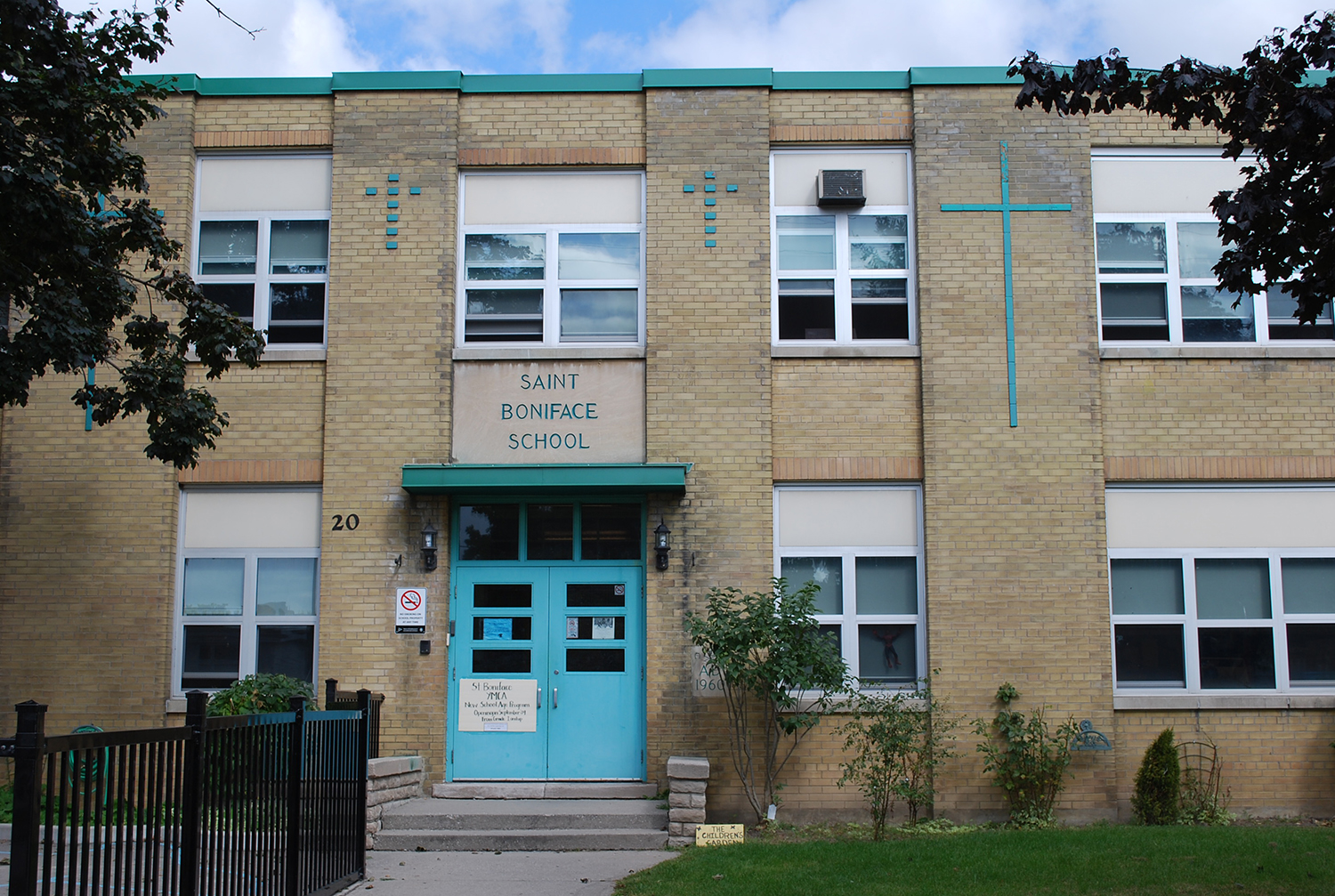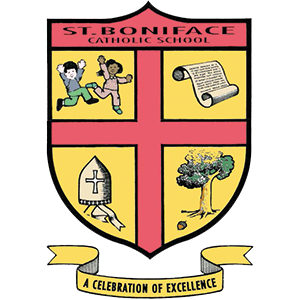
Our School
About Us
At St. Boniface Catholic School, we pride ourselves on the strong partnership that exists among the home, the school and the parish.
Our staff is committed to providing our students the opportunity to engage in authentic and rich performance tasks that enable them to demonstrate their greatest potential and achieve the highest level of success. Our inquiry-based professional learning and instructional practices contribute to the culture of learning in our school, as we understand that different students learn differently. Our educators identify the strengths and needs of our students in order to program and develop learning goals, incorporate differentiated instruction and differentiated evaluation, incorporate intervention practices, utilize the expertise of our support staff, and integrate technology as we move into 21st century learning.
How We Meet the Diverse Needs of Our Students
At St. Boniface, our primary focus is on fostering a Christ-centered learning environment. This in turn encompasses a safe, inclusive, healthy, and enjoyable learning environment, where students, staff, parents, and the parish come together regularly to celebrate the Eucharist.
Spiritual: St. Boniface Catholic School strives at all times to be a community enlivened by the spirit of the Gospel. It is a place of living as well as learning, a community which seeks to provide excellence in its pursuit of learning and to assist young people in developing their natural talents and abilities. Essential to the mission of our school is the union of the true Christian community - family, school and church working closely together.
Within the religious education, guidance, health and family life programs, the importance of prayer and celebration of our Catholicity are constantly stressed. Students are encouraged to know and understand themselves and develop a positive self-image. Time is devoted by staff to the counselling of students vis-à-vis their moral, social, emotional and intellectual development. In addition, we have Masses to celebrate the Eucharist as a community, and a Rosary program throughout the year, conducted by parishioners of St. Boniface.
We are continuing to promote anti-bullying awareness, as well as a more general Safe Schools policy, to ensure that St. Boniface students work and play in a caring, secure environment.
We are promoting character development through our “What Would Jesus Do?” theme, which is woven into daily activities here at the school.
Educational: Our English as a Second Language (ESL) and Special Education programs address the needs of students. A reading partners program matching primary and intermediate students is conducted weekly to provide more opportunities for individualized attention for our primary students and to expose them to a richer variety of reading materials.
With a full computer laboratory in our school library, as well as computers in classrooms, through which the students at St. Boniface are becoming more familiar with their use of modern technology. This will assist them to become confident and creative problem-solvers.
We are part of the Professional Learning Network, which promotes the sharing of professional expertise among educators and continuous instructional improvement.
Community: St. Boniface joined the Best Start program in the fall of 2006. The Best Start program, which caters to kindergarten-aged children, is a comprehensive early learning and care strategy that offers integrated services for children. Its mandate covers the standard working day (7:00 AM to 6:00 PM). It is publicly funded and not-for-profit. It includes parenting components (e.g. Ontario Early Years Centre programs and family resource programs), optional nutrition programs, and the integration of a variety of programs from community services and agencies. In addition, we have the After-School Recreation Care (ARC) program, a snack food program and a daily milk program.
Our school is involved with the Merry-Go-Round program. Its website describes the program as a volunteer effort which brings together members of the educational, policing and corporate communities to share their expertise by donating complete state-of-the-art home computer systems including internet access to those children who are observed by teachers to embody a passion for learning and the potential to excel academically if given more opportunity. Merry–Go-Round has been one of the most successful initiatives within our school community.
St. Boniface has promoted a series of Family Night programs. These have included parenting programs conducted by Aisling Discoveries Child and Family Centre, and a Family Math Night in which parents and caregivers had an opportunity to experience the current mathematics program. In addition, we have had a Reading Night, which promoted the joys of shared reading between adult and child. All were successful in promoting community involvement.
St. Boniface sends many students to summer camps such as Four Winds Boys’ Camp and Marygrove Girls’ Camp. These camps give our students an opportunity to live and grow within a non-urban environment over the summer months.
We also liaise with the police service though programs such as “Values Influences and Peers” for our Grade 6 students, and anti-gang presentations for our intermediates. In addition, we also liaise with Aisling Family Services Discoveries Program and The Canadian Association Mental Health (CAMH) centre provide programs for student programming and parent workshops.
Our Patron Saint
Saint Boniface, called the Apostle of the Germans, was actually born in England in 672, at Crediton in Devon, and baptized Winfrid. He received his theological training in the Benedictine monasteries of Adescancastre. He taught in the abbey school and at the age of thirty became a priest. He wrote the first Latin grammar book produced in England.
His first mission was in 716, when he set out for Frisia, which today is the Dutch province of Friesland. An ongoing war in the area frustrated his attempt to convert the Frisians, and he returned to England.
In 718, he visited Rome, and was commissioned in 719 by Pope Gregory II, who gave him his new name of Boniface, to evangelize in Germany and reorganize the church there. Five years later, on November 30, 722, he was elevated to bishop of the German territories.
Following a third trip to Rome, Boniface went to Bavaria and founded the bishoprics of Salzburg, Regensburg, Freising and Passau.
He was also involved with the growth of Christianity in modern-day France.
Still hoping to convert the Frisians, he set out in 754 with a small retinue for Frisia. He baptized a great number, and summoned a general meeting for Confirmation at a place not far from Dokkum, which is today a Dutch town in the province of Friesland. However, a group of armed men appeared instead, who martyred the archbishop and all those with him.
His remains were eventually buried in a shrine beneath the high altar of Fulda cathedral, in the abbey of Fulda, which is near the German city of Frankfurt. Saint Boniface is the patron saint of Germany and of the archdiocese of Saint Boniface, Manitoba. He is also the patron saint of World Youth Day.
His feast day is June 5.
Our School History and Tradition
St. Boniface Catholic School opened its doors for the first time, as a 12-classroom school, on September 1, 1960. A gymnasium and two new classrooms were added to the original structure in 1966. A final building addition, which presently houses the school library and two kindergarten classrooms, was completed in 1968.
An increase in the student population over the years has resulted in the addition of a number of portable classrooms. We currently have a school population of about 400 students from Junior Kindergarten to Grade 8. Our students reflect the multicultural diversity of our city. In the 2010-2011 school year, St. Boniface reached a milestone in Catholic education, celebrating its 50th anniversary.

